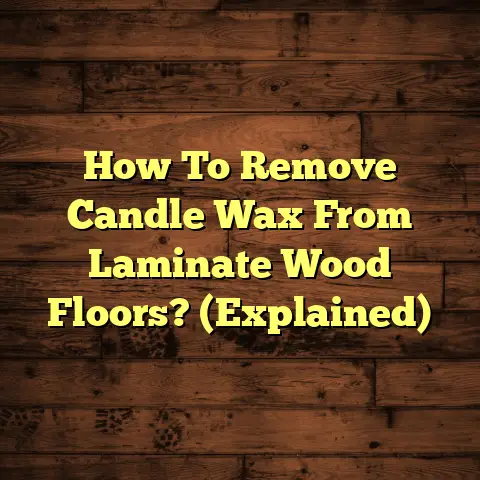Homemade Bona Floor Cleaner: A Diy Recipe? (Explained)
I remember the day I decided to take on the challenge of cleaning my hardwood floors with a homemade solution.
The sun was streaming through the windows, casting a warm glow on the polished surface, but I could see those pesky dust particles dancing around.
My floors looked dull, and I felt frustration creeping in as I thought about the commercial cleaners filled with chemicals that might damage my floors over time.
I wanted something effective yet safe for my family and pets.
That’s when I stumbled upon the idea of making my own Bona floor cleaner.
Why Go Homemade?
Why did I choose to go the DIY route?
For starters, it’s all about control.
When I make my own cleaner, I know exactly what goes into it.
No harsh chemicals, just simple ingredients that won’t harm my floors or my loved ones.
Plus, it’s cost-effective!
Let’s break down how I crafted my own version of Bona floor cleaner, and maybe you can find it just as satisfying.
Ingredients You’ll Need
Here’s what I gathered from my kitchen and pantry:
- Water: 1 gallon (distilled if possible)
- White vinegar: ½ cup
- Dish soap: 1 teaspoon (preferably a gentle formula)
- Essential oil (optional): a few drops for fragrance (I love using tea tree or lavender)
The Mixing Process
- Find a Suitable Container: I grabbed an empty spray bottle, which is perfect for easy application.
- Combine the Ingredients: In the bottle, I mixed the water, white vinegar, and dish soap.
If I wanted a nice scent, I’d add a few drops of essential oil. - Shake It Up: After sealing the bottle, I shook it gently to ensure everything was well combined.
Application Tips
When it was time to clean, I made sure to sweep or vacuum the floors first.
Nothing worse than dirt scratching your beautiful hardwood!
- Spray Sparingly: I sprayed a light mist over a small section of the floor.
- Wipe with a Microfiber Cloth: Using a microfiber cloth, I wiped in the direction of the wood grain.
This helped lift dirt without leaving streaks. - Rinse: Occasionally, I’d rinse my cloth in clean water to avoid spreading dirt around.
Successes and Challenges
Let me tell you, this cleaner worked wonders!
My floors shined brighter than ever.
However, there were challenges too.
Initially, I used too much vinegar, which left an unpleasant smell for a while.
It took me a couple of tries to find the right balance.
Cost Consideration
Using FloorTally in my flooring tasks has been invaluable when estimating costs.
With my flooring projects, knowing material prices and labor rates upfront helps me create realistic budgets.
For instance, while sourcing ingredients for my homemade cleaner, I realized that the total cost was just around $2-$3 compared to commercial cleaners that often cost $10 or more.
Comparing Other Options
In my quest for effective cleaning solutions, I’ve tried various commercial products and other homemade blends.
Here’s a quick breakdown:
- Commercial Cleaners: Often effective but filled with chemicals.
Some left residues that attracted more dirt. - Other DIY Recipes: Some used baking soda or rubbing alcohol, which I found too abrasive for my delicate hardwood.
Tips for Maintenance and Usage
Here’s what I’ve learned through trial and error:
- Frequency of Cleaning: Regular cleaning (once a week) keeps dirt from building up and makes deep cleaning easier.
- Avoid Excess Water: Hardwood floors don’t like too much moisture.
A damp cloth is better than soaking wet. - Store Properly: Keep any leftover cleaner in a cool, dark place to maintain its effectiveness.
Understanding Hardwood Floors
Hardwood floors are not just about aesthetics; they require specific care to maintain their beauty.
Understanding the type of finish on your hardwood—whether it’s oil-based or water-based—can influence your cleaning methods.
Each type reacts differently to various cleaning agents.
Oil-Based vs Water-Based Finishes
Oil-based finishes tend to be more durable but can take longer to dry.
Water-based finishes dry quickly but might require more frequent touch-ups.
Knowing this helps me decide the right cleaning approach and frequency.
Dealing with Stains
Over time, I’ve faced my fair share of stains on hardwood floors.
From wine spills at parties to muddy footprints from our four-legged friends, stains can be daunting.
Here are some tips based on my experiences:
- Act Quickly: The sooner you deal with a stain, the better chance you have at removing it entirely.
- Use a Gentle Approach: For sticky substances, I always start by gently scraping with a plastic spatula before applying any cleaner.
- Spot Test: Whenever trying out a new cleaner (even homemade), I always do a spot test in an inconspicuous area first.
Additional Cleaning Solutions
If you’re curious about other homemade cleaning solutions beyond Bona-style cleaners, here are some alternatives I’ve experimented with:
- Baking Soda Paste: Mixing baking soda with water creates a paste that can tackle tough stains.
Apply it directly to the stain and let it sit for 10-15 minutes before wiping away. - Olive Oil and Vinegar Mix: For a natural polish, combining olive oil and vinegar can restore shine while conditioning the wood.
Seasonal Cleaning Routines
As seasons change, so do my cleaning routines.
For example, during spring cleaning, I like to perform a deeper clean:
- Move Furniture: This gives me a chance to clean under heavy pieces that usually get neglected.
- Inspect for Damage: While cleaning, I check for scratches or signs of wear that might need attention.
- Reapply Finish if Necessary: Sometimes, wood floors need a fresh coat of finish to bring back their luster.
Regular Maintenance Tips
Beyond deep cleaning sessions, regular maintenance is key to keeping hardwood floors looking their best:
- Use Rugs Wisely: Placing rugs at entryways can help trap dirt before it gets onto your floors.
- Furniture Pads: Applying felt pads under furniture legs prevents scratches when moving items around.
- Humidity Control: Maintaining proper humidity levels in your home protects wood from expanding or contracting excessively.
Dealing with Scratches
Over time, even with careful cleaning practices, scratches can occur.
Here’s how I manage them:
- Wax Crayons: For minor scratches, coloring them in with a wax crayon that matches your floor can be surprisingly effective.
- Scratch Repair Kits: Many brands offer kits specifically designed for repairing hardwood floor scratches.
These often include markers and fillers that blend seamlessly.
Engaging Family Members
Cleaning doesn’t have to be a solo task!
Involving family members can make it more enjoyable:
- Create a Cleaning Playlist: Music always makes chores more fun!
We jam out while tackling our cleaning routine together. - Set Challenges: Friendly competitions can motivate everyone to contribute—like seeing who can collect the most dust bunnies!
How FloorTally Helps Me
As an experienced flooring contractor, I often juggle multiple projects at once.
FloorTally has been pivotal in managing estimates not only for installation but also for ongoing maintenance tasks like cleaning supplies.
For instance, when planning a new project involving hardwood floors:
- Material Costs: It lets me easily calculate costs based on current local prices for materials and labor.
- Client Transparency: By providing detailed estimates upfront, clients feel more comfortable with budgeting for both installation and maintenance products.
- Time Management: Having everything organized in one platform saves me hours of back-and-forth communication.
DIY Cleaning vs Store-Bought Cleaners
I’ve gone down both paths—using store-bought cleaners and making my own—and here’s what I’ve learned:
- Cost Efficiency: Homemade cleaners are significantly cheaper in the long run.
- Effectiveness: While some store-bought options are very effective, many of them contain chemicals that can harm both health and floors over time.
- Environmental Impact: DIY solutions often have less environmental impact compared to commercial cleaners laden with harsh chemicals.
Creating Your Own Cleaning Routine
Now that you have the recipes and tips I’ve found useful, you can craft your own cleaning routine based on your lifestyle:
- Identify Your Needs: How often do you walk on your floors?
Do you have pets?
Tailor your routine accordingly. - Set Reminders: Use calendar reminders to keep track of cleaning schedules to ensure consistency.
- Evaluate and Adjust: After implementing your routine for a month or so, evaluate its effectiveness and adjust as needed.
Conclusion: Embracing DIY Solutions
Building your own cleaning products not only enhances your home environment but also empowers you as a homeowner or contractor.
The journey from experimenting with various recipes to finding what works best has been both rewarding and enlightening.
Have you tried making your own floor cleaner?
What ingredients worked best for you?
Share your experiences!
Cleaning doesn’t have to be a chore; it can be an empowering process where you take charge of your home’s maintenance.
With a little effort and creativity, you’ll find that keeping those hardwood floors looking pristine is not only achievable but enjoyable!





